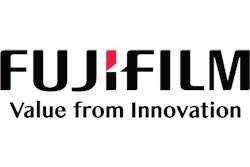CHICAGO - Long known for its computed radiography (CR) technology, Fujifilm Medical Systems USA of Stamford, CT, is using this week's RSNA show as a springboard to highlight its launch of the company's first radiography systems based on solid-state digital detectors. The company is also making the most of momentum generated by regulatory approval of its CR mammography system, and is also showing new enhancements for its Synapse line of PACS software.
Mammography
Fuji's FCRm system received U.S. Food and Drug Administration approval in July, and in its RSNA booth the company is highlighting its experience in CR mammography, which it has been shipping internationally for many years. Fuji has a 50% share of the worldwide market for full-field digital mammography (FFDM) systems, and the company's systems were used to produce 30% of the studies in the recent Digital Mammographic Imaging Screening Trial (DMIST) in the U.S.
In its RSNA booth, Fuji is discussing how CR mammography can fit into the workflow of a typical breast imaging practice. The company is also highlighting the ease with which users can customize FCRm display parameters to suit their needs.
Fuji is also pointing out the advantages of FCRm to users of the company's Synapse software. For example, the FCRm technologist console can also be used to access Synapse studies, bringing PACS access into the exam room. Fuji also has a Synapse toolset that it can install for FCRm users.
Fuji is also offering computer-aided detection (CAD) applications to FCRm purchasers, from either the R2 Technology subsidiary of Hologic of Bedford, MA, or from iCAD of Nashua, NH.
At the RSNA show, Fuji is announcing an agreement with Siemens Medical Solutions that gives the Malvern, PA-based multimodality vendor rights to distribute FCRm as a complement to the company's own Mammomat Novation DR system, which is based on solid-state digital FFDM technology.
Finally, Fuji is touting recent contracts to install FCRm at the University of North Carolina in Chapel Hill and Solis Women's Health (formerly Women's Diagnostic of Texas) in Austin, TX.
X-ray
Fuji's move into flat-panel solid-state DR is being spearheaded by two new systems, Velocity-Ufp and Velocity-Tfp, which can be combined into a single digital room replacement that Fuji is calling Dual SpeedSuite. Velocity-Ufp is a chest reader designed for upright exams, with a throughput of 240 images per hour, while Velocity-Tfp is a table-based system that uses a solid-state digital detector.
The detector was developed by Fuji and is based on cesium bromide technology, with a 100-micron pixel size and a 17 x 17-inch detector size. The chest system will begin shipping in January, while the table will begin shipping in March. Fuji already sells a version of the table with CR technology.
Another new DR introduction is SpeedSuite Unity, a U-arm-based system designed to offer patient positioning flexibility in a package that's more economical than a ceiling-suspended radiography system. The system will be available with either a storage-phosphor or solid-state detector, and will use the same Image and Information Processor (IIP) technologist console found on other Fuji products.
SpeedSuite Unity is being shown as a work-in-progress, and is scheduled to begin shipping in mid-2007. Fuji estimates that the storage-phosphor version of the system will carry a list price that's 30% lower than the solid-state version.
In other x-ray news, FCR Pocket ID is a new handheld computer that's loaded with the company's Flex UI software for digital x-ray applications. The product enhances technologists' efficiency by enabling them to download patient information from the workstation, then move throughout a facility to perform exams. Pocket ID also replaces manual data entry with electronic bar code entry.
IT/PACS
On the PACS side, Fuji is highlighting version 3.2 of its Synapse software. The new version is designed to assist healthcare facilities with the workflow, visualization, and image processing for the interpretation of FFDM studies.
Digital mammography has a unique workflow that includes screening and diagnostic workflows, as well as the necessity for comparison models, multimodality display capabilities, and the integration of CAD results, according to the company.
Fuji's Synapse version 3.2 extends Fuji's Reading Protocol technology to enable the setting of reader-specific preferences for efficient and consistent screening workflows. In addition, its multimodality capabilities allow FFDM data to be integrated into other women's healthcare imaging technologies, including ultrasound and MR.
Synapse 3.2 provides additional features to enhance the presentation of image data, such as support for Mammography Quality Standards Act (MQSA)-compliant overlays, the integration of CAD into the technologist and radiologist workflow, and support for Fuji's AON compression algorithm.
Fujifilm also is partnering with Indianapolis-based cardiology information management firm Problem Solving Concepts (ProSolv) to combine ProSolv's cardiology software and Fuji's Synapse PACS for radiology. The goal is for cardiologists to launch Synapse from within the cardiac application and for radiologists to link directly to ProSolv.
Fuji also is working with Web-based HIS provider Empiric Systems of Morrisville, NC, to develop a fully scalable RIS/PACS for outpatient imaging facilities.
Fuji will contribute its Synapse PACS, while Empiric offers its Encompass.NET RIS to create a streamlined, full-featured RIS/PACS to smaller radiology departments and imaging centers that have lower volumes of images. To that end, Fuji has created a number of customizable Synapse configurations, including server and storage offerings, as well as pay-per-use licensing and a financing program.
The Fuji/Empiric RIS/PACS software is available now and is being rolled out at customer sites.
By Brian Casey and Wayne Forrest
AuntMinnie.com staff writers
November 29, 2006
Copyright © 2006 AuntMinnie.com



















